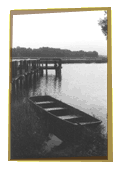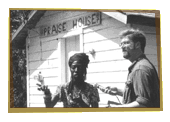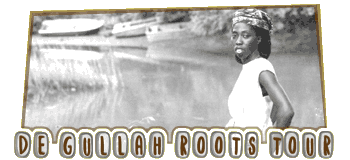 |
 |
 |
|
|||
|
De Gullah Roots Tour
Goodwine: (Speaks in Gullah, then translates): "If you don't know where you're from, you don't know where you're going." Marquetta Goodwine knows where she came from. Her west African ancestors were brought as slaves onto American soil here on these narrow docks. We're now standing on a landing, ringed by palmetto and pines, looking out over the water where descendents of Africans now make their daily catch of shrimp and fish. 
There is an incredible serenity at this landing, and across St. Helena Island. Huge oaks branch out like fortresses, draped in gray beards of Spanish moss. This serenity has always held a powerful sway over Goodwine. After earning college degrees in New York City, she returned several years ago to work full-time for the Gullah people.
Goodwine: "In the mornings I'd get up with the dew on the ground, and I'd hang my clothes on the line every day, and I could feel it, I could hear the ancestors saying we have work for you. Goodwine's work in defending Gullah land rights, and maintaining their cultural traditions, has earned her the elected title of Queen Quet, chieftess of the Gullah-Geechee people, who number over 500,000. This requires her to travel around the country giving presentations. In 1999, she also spoke at the United Nations in Geneva, Switzerland. Along with a string of other duties, Goodwine also leads De Gullah Roots Tour, a heritage excursion around the islands.
Goodwine: "The things that are done here in terms of tourism are what we call cultural tourism. And that's to make people aware of our history, heritage and culture through a number of means. Through the food ways, through the crafts, the quilting, the netting, but more so than that, through the interaction with the people. If you're not interacting with us who are native, you never really get the full story, the full feel. You never get the Gullah experience." As a performer and writer, Goodwine has a compelling presence. Her Gullah experience often begins in song. Goodwine sings spirituals: "Get away..." Our first stop is one of the last surviving Praise Houses. It's an old, white-washed wooden hut, surprisingly small, accommodating no more than 50 people. Slavery laws forbade large gatherings of Africans. Here they shaped new rituals from a blend of Christian and African traditions. Still today, says Goodwine, the community gathers and finds meaning here.
Goodwine: "The spirit leads in the praise house. You have a praise house elder, which for the most part have been males. And then you have women of the community, who are respected mothers of the praise house, and they'e the ones who keep the praise house clean, who really are the ones with the wisdom and insight, that can help guide and deal with matters in the community." From the Praise Houses came the spirituals, many with the call and response rhythm of African tradition. During the era of slavery, you could hear the singing through the forest and even across the water, to the mainland plantations. But, says Goodwine, only the slaves knew that some spirituals carried a hidden message. 
Goodwine: "They would hear across the water all that singing. And when we heard it, we knew someone was getting away, someone was leaving the plantation. There was that code in it. And they would say, yessir boy, it's happening now, we'll be in that field in the morning." Goodwine adds that Gullah, a mix of African & English vocabulary and syntax, can carry hidden messages, giving those who speak it an advantage over those who don't.
Goodwine: "They always thought we were trying to break up their language. And they never paid attention to the fact that there was another set of things being said that they didn't understand. They just thought this was broken English." After we tour a family compound, and make a visit to a Gullah-owned community store, we arrive at the ruins of the Chapel of Ease, an 18th century church tucked under towering oak trees and wandering vines. The jagged walls are built of tabby, a cement made from lime, sand and ground oyster shells that is still found in West Africa. Although the chapel was built by slaves for their owners and plantation families, Goodwine sees her African heritage reflected in the tabby ruins.
Goodwine: "It represents Gullah during the era of slavery for me, the Chapel of Ease. It is really hallowed ground. They had Gullah-Geechee people build this chapel, which is all hand done. It has a lot of the spiritual power and energy that I know my ancestors had, that they put into this work." With several walls intact, the chapel is peaceful and haunting: a natural place for meditation. Goodwine takes me to visit a community development center, which has just launched a computer training program, and then to another important historical site, the Penn Center, one of the first schools for emancipated African Americans in the United States, and where Martin Luther King, Jr., held annual strategy sessions. Then then we go to our welcome reward:
Pam Coaxun: "I gave you white rice, with shrimp gumbo on top. In the gumbo is okras, green beans, corn, and whole tomatoes. And also with this, you're going to get collard greens, potato salad and corn bread." The Gullah Grub is a food stand set up on the side of the main road. For cook and organizer Ted "Gullah Boy" Moyd, it is evidence of the thriving Sea Island culture.
Moyd: "We're trying to preserve the native heritage here. And we're doing that through food." While a long line of tourists and locals starts to form for the Gullah Grub, I overhear older people conversing in Gullah. Nearby, children chase each other around the park and oak trees. Despite signs in the Sea Islands advertising the encroaching golf courses and resorts, which are increasingly displacing the Gullah people, I realize the real Sea Island experience is here, under the trees and vines, and as Marquetta Goodwine promised, among the islanders. That experience - the Gullah experience - is as powerful as the shrimp and gumbo, on this hot and humid day, the spicy aroma drifting with an appreciated breeze, just waiting for people to cross over to this island and savor its richness.
Goodwine (reciting poem): "I sit on the porch shelling the peas and watch the spirit of grandma fan the rice. Do um right de fuss time an hunnuh won hafa do um twice. I see the beauty in each grain as the wind blows away the husk. I hear the rhythm of the earth drum as the day turns to dusk. Some people feel shame in who they must be, but go ahead and say Geechee and Gullah because all that is me."
|
 | American Public Media Home | Search | How to Listen ©2004 American Public Media | Terms of Use | Privacy Policy |
